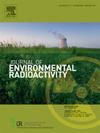温度-压力耦合作用下花岗岩实时氡释放规律研究
IF 2.1
3区 环境科学与生态学
Q3 ENVIRONMENTAL SCIENCES
引用次数: 0
摘要
铀矿石作为一种重要的能源矿物,在开采过程中伴随着放射性气体氡的释放。为了研究深部地层温度-压力耦合状态下花岗岩内部氡气及其子体的释放规律,本实验采用不同温度梯度(25℃、50℃、75℃、100℃、150℃、200℃、250℃、300℃)下的单轴压缩实验,实时监测氡释放变化,探讨不同温度对花岗岩内部氡释放行为的影响。实验结果表明:随着应变的增加,花岗岩的氡释放量整体呈现先增加后减少再增加的趋势,并在裂纹不稳定扩展阶段达到峰值。在100 ~ 150℃的压缩致密阶段,氡释放量减少28.45%,在150 ~ 200℃的裂纹扩展阶段,氡释放量增加29.33%。温度-压力耦合效应显著影响花岗岩的氡释放行为和高温。温度-压力耦合显著影响花岗岩的氡释放行为,高温导致花岗岩的力学性能下降,加速矿物晶体间和晶体内水分的蒸发和矿物的热膨胀,从而促进氡气的释放;此外,热损伤和微裂纹的产生为氡气迁移提供了新的通道。该研究为深入了解温度-压力耦合条件下花岗岩的氡释放规律,制定科学的防治策略提供了重要依据。本文章由计算机程序翻译,如有差异,请以英文原文为准。
Study on the real-time radon release pattern of granite under temperature-pressure coupling
Uranium ore, as an important energy mineral, is accompanied by the release of radioactive gas, radon, during the mining process. In order to study the release law of radon gas and its daughters inside granite under the state of temperature-pressure coupling in the deep stratum, the experiment uses uniaxial compression experiments under different temperature gradients (25 °C, 50 °C, 75 °C, 100 °C, 150 °C, 200 °C, 250 °C, and 300 °C) and real-time monitoring of radon release changes, to explore the effect of different temperatures on the behavior of radon release inside granite. The experimental results show that: with the increase of strain, the radon release of granite as a whole shows the trend of increasing, then decreasing, and then increasing again, and reaches the peak in the unstable propagation stage of cracks. The radon exhalation decreases by 28.45 % in the stage of compression and densification at 100–150 °C, and increases by 29.33 % in the stage of expansion of cracks at 150–200 °C. The temperature-pressure coupling effect significantly affects the radon release behavior of granite, and the high temperature. The temperature-pressure coupling significantly affects the radon release behavior of granite, with high temperatures leading to a decrease in the mechanical properties of granite and accelerating the evaporation of water between mineral crystals and within the crystals and the thermal expansion of minerals, which in turn promotes the release of radon gas; in addition, the generation of thermal damages and microcracks provides new channels for radon gas migration. This study provides an important basis for the in-depth understanding of the radon release law of granite under temperature-pressure coupling conditions and the formulation of scientific prevention and control strategies.
求助全文
通过发布文献求助,成功后即可免费获取论文全文。
去求助
来源期刊

Journal of environmental radioactivity
环境科学-环境科学
CiteScore
4.70
自引率
13.00%
发文量
209
审稿时长
73 days
期刊介绍:
The Journal of Environmental Radioactivity provides a coherent international forum for publication of original research or review papers on any aspect of the occurrence of radioactivity in natural systems.
Relevant subject areas range from applications of environmental radionuclides as mechanistic or timescale tracers of natural processes to assessments of the radioecological or radiological effects of ambient radioactivity. Papers deal with naturally occurring nuclides or with those created and released by man through nuclear weapons manufacture and testing, energy production, fuel-cycle technology, etc. Reports on radioactivity in the oceans, sediments, rivers, lakes, groundwaters, soils, atmosphere and all divisions of the biosphere are welcomed, but these should not simply be of a monitoring nature unless the data are particularly innovative.
 求助内容:
求助内容: 应助结果提醒方式:
应助结果提醒方式:


